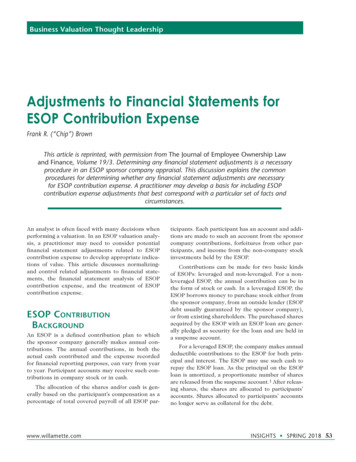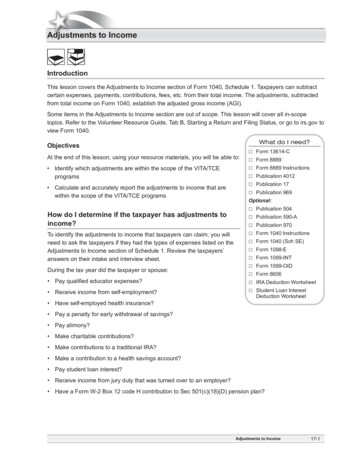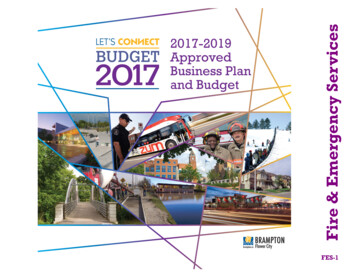
Transcription
Business Valuation Thought LeadershipAdjustments to Financial Statements forESOP Contribution ExpenseFrank R. (“Chip”) BrownThis article is reprinted, with permission from The Journal of Employee Ownership Lawand Finance, Volume 19/3. Determining any financial statement adjustments is a necessaryprocedure in an ESOP sponsor company appraisal. This discussion explains the commonprocedures for determining whether any financial statement adjustments are necessaryfor ESOP contribution expense. A practitioner may develop a basis for including ESOPcontribution expense adjustments that best correspond with a particular set of facts andcircumstances.An analyst is often faced with many decisions whenperforming a valuation. In an ESOP valuation analysis, a practitioner may need to consider potentialfinancial statement adjustments related to ESOPcontribution expense to develop appropriate indications of value. This article discusses normalizingand control related adjustments to financial statements, the financial statement analysis of ESOPcontribution expense, and the treatment of ESOPcontribution expense.ESOP ContributionBackgroundAn ESOP is a defined contribution plan to whichthe sponsor company generally makes annual contributions. The annual contributions, in both theactual cash contributed and the expense recordedfor financial reporting purposes, can vary from yearto year. Participant accounts may receive such contributions in company stock or in cash.The allocation of the shares and/or cash is generally based on the participant’s compensation as apercentage of total covered pay roll of all ESOP par-www.willamette.comticipants. Each participant has an account and additions are made to such an account from the sponsorcompany contributions, forfeitures from other participants, and income from the non-company stockinvestments held by the ESOP.Contributions can be made for two basic kindsof ESOPs: leveraged and non-leveraged. For a nonleveraged ESOP, the annual contribution can be inthe form of stock or cash. In a leveraged ESOP, theESOP borrows money to purchase stock either fromthe sponsor company, from an outside lender (ESOPdebt usually guaranteed by the sponsor company),or from existing shareholders. The purchased sharesacquired by the ESOP with an ESOP loan are generally pledged as security for the loan and are held ina suspense account.For a leveraged ESOP, the company makes annualdeductible contributions to the ESOP for both principal and interest. The ESOP may use such cash torepay the ESOP loan. As the principal on the ESOPloan is amortized, a proportionate number of sharesare released from the suspense account.1 After releasing shares, the shares are allocated to participants’accounts. Shares allocated to participants’ accountsno longer serve as collateral for the debt.INSIGHTS SPRING 2018 53
Normalizing- and ControlRelated Adjustments toFinancial StatementsOne must understand normalizing and controladjustments to financial statements before attempting to apply such adjustments to an ESOP sponsor company, and specifically ESOP contributionexpense. There are five primary types of financialstatement adjustments:1.AccountingAccountingadjustmentsor GenerallyPrinciples2.Nonrecurring adjustments3.Accepted(“GAAP”)nexpenses (not expected going forward) associated with the ESOP installation; andnelimination of past items that might tendto distort the company’s current and futureearning power.Non-Arm’s-Length TransactionAdjustmentsThese adjustments relate to related-party transactions and often discretionary expenses. These itemsare more common in privately held companies.Some examples include:nexcess compensation paid to the owner(s)or to the family members of the owner(s),Non-arm’s-length transactions adjustmentsnnonmarket rent paid to the owner(s), and4.Financial control adjustmentsn5.Separation of operating and nonoperatingitemspersonal travel and entertainment expensesof the owner(s).While these adjustments appear somewhat similar at first, there are specific valuation impacts ofeach. The differences between the five types ofadjustments can be significant from a fair marketvalue perspective. The characteristics and distinctions of the five adjustment types are summarizedbelow.Accounting/GAAP AdjustmentsAccounting-related adjustments are generally madebecause (1) the financial statements of the subject company and/or the guideline companies areinconsistent in accounting policies/reporting (e.g.,aggressive or “low” quality vs. conservative or“high” quality) and (2) certain financial statementitems prepared according to GAAP may need to beadjusted to something that better reflects economicreality. Some examples include:ndepreciation methods,ninventory accounting,nrevenue recognition issues, andnnet operating losses.Nonrecurring Item AdjustmentsThese adjustments relate to certain specific or isolated events that affected the subject company’s pastearnings performance. Some examples include:nunusual gains or losses on sale of assets;nlawsuit settlements;nproperty loss due to fire, hurricane, flood,etc., not covered by insurance;54 INSIGHTS SPRING 2018For purposes of this article, non-arm’s-lengthtransactions are discussed separately from financialcontrol adjustments. There is a difference of opinionamong appraisers on whether adjusting non-arm’slength transactions, such as nonmarket owner compensation, represents “control” adjustments, andwhether these adjustments should be made whenvaluing a noncontrolling interest. Further discussion on this disagreement is beyond the scope ofthis article.Financial Control AdjustmentsThese adjustments relate to economies or efficiencies available to the typical financial buyer (whichmay or may not be present in the subject companyat the time of appraisal), and not present on the asif-freely-traded basis.2 Prospective financial controlbuyers may consider adjustments that can improvethe normalized earnings stream. These adjustmentsmay also be a result of better management, whichmay also affect the expected growth rate of adjustedearnings.3Separation of Operating andNonoperating ItemsAppraisers may adjust historical and/or projectedfinancial statements of the ESOP sponsor companyto exclude income or expense associated with anonoperating asset or liability. For example, apractitioner may remove income associated witha rent property owned by a manufacturing company (i.e., renting properties not part of the coreoperations). If this income is removed from thehistorical and/or projected financial statements ofwww.willamette.com
the subject company, thevalue of the real estate (lessany debt associated with it)should be included in thetotal indicated value of thecompany (e.g., added to theindicated value of equity ofthe operating company).ESOP ContributionExpense FinancialStatement AnalysisBefore an analyst candecide whether to makeadjustmentsassociatedwith ESOP contributions,he or she should firstunderstand what is beingadjusted. Specifically, theanalyst should have a general understanding of theaccounting associated withESOP contribution expense, and ultimately theimpact on the financial statements. For example,the analyst may make adjustments for financialstatement items that may be in accordance withGAAP but do not make economic sense for valuation purposes.As ESOP shares are committed to be released,unearned ESOP shares should be credited, and generally ESOP contribution expense should be debitedor charged.4 The amount of the entry should be basedon the fair values of committed-to-be-released shares.Thus, as the sponsor company shares increase invalue, the ESOP contribution expense increases aswell.Under AICPA Statement of Position 93-6, compensation/benefit expense is based on the fair valueof the shares allocated, released, or committed tobe released for any payments made on the ESOPdebt that year. Hence, even if the company makesthe same cash contribution amount each year, theexpense on the in come statement could fluctuatesignificantly if the share price has increased ordecreased by a substantial amount.The contribution expense could also vary significantly even if the share price has not. For example,if the sponsor company has made contributionsto the ESOP greater than the required contribution for the principal and interest payments, theexcess contribution amount is expensed in thecurrent period. In future years, when that excesscontribution is used to make debt payments, thewww.willamette.comdifference between (1) the fair value of the sharesreleased in the future period and (2) the expenseamount already recognized in the previous periodis recorded as an expense (if the share price hasincreased) or a credit to expense (if the share pricehas decreased).Other Reasons for Variance inContribution ExpenseSignificant variance in the contribution expense isnot limited to leveraged ESOPs. Even after the debthas been repaid, contribution expense may be aboveor below a normal level of benefits due to repurchases of participants’ shares.The contribution expense associated withrepurchased shares depends on whether the sharesare “redeemed” (considered a capital transactionthat does not affect the income statement) or“recycled” (expense recorded at the fair value ofthe shares times the number of shares recycled).If the shares are recycled, the associated con tribution expense may be above a market/normallevel of benefits if there is a significant number ofrecycled shares and/or there has been a significantincrease in the share price.Whatever the reason that contribution expenseis higher than normal/market, a practitioner stillfaces the same decisions regarding the treatmentof ESOP contribution expense in a valuationanalysis.INSIGHTS SPRING 2018 55
Treatment of“Leveraged ESOPsESOP Contributiongenerally haveExpense in amore fluctuationValuation Analysisand often higherlevels of ESOPcontributionexpense.”As described previously, ESOPcontribution expense (on aGAAP basis) can vary significantly even if the ESOP sponsorcompany makes consistent cashcontributions. In addition, somepeople question whether GAAP accounting for contribution expense reflects the true economic realityof the cost a hypothetical willing buyer or seller ofthe ESOP company shares would consider.However, adjusting to a “market level” of benefitexpense may not be appropriate. Unless there is asignificant reduction in share price, the ESOP willeventually have to repurchase those participantshares at fair market value. Another issue arisesregarding the use of a market level of benefits ifESOP contribution expense is expected to remainhigh going forward for the subject company and anacquisition of the company is unlikely.a greater number of sharers, and (2) itgenerally increases the equity price morequickly because the debt is paid downfaster.nA sponsor company with a new ESOP canhave more fluctuation in stock price than alater-stage ESOP sponsor company, whichdirectly affects the recognition amount ofESOP contribution expense on the incomestatement.nA mature ESOP sponsor company may facea significant repurchase obligation. If theESOP sponsor company decides to recyclea significant number of shares to minimizethe cash flow impact, the ESOP contribution expense may be higher than normal.nIt is unlikely that ESOP contributionexpense will be a consistent percentage ofrevenue over time for many ESOP sponsorcompanies, which might lead a hypothetical willing buyer and seller to negotiate asale price on a normalized contribution/benefit level or the expectation of theESOP contribution expense going forward.nParticipants could leave before they arefully vested and may not realize the fullbenefit that was recorded as an expense bythe company in a previous period.nA purchase study may help better understand the level of contribution expensegoing forward (e.g., if a significant numberof shares are expected to be put back inthe next few years, and the company planson recycling such shares).Factors to ConsiderThere is not a definitive answer for how to alwaystreat ESOP contribution expense in an analysis. Itis an analyst’s judgment based on the specific characteristics of the subject ESOP sponsor company.However, there are certain factors that should beconsidered in appropriate treatment of ESOP contribution expense in a valuation analysis. Some ofthe factors to consider are as follows:nnLeveraged ESOPs generally have morefluctuation and often higher levels of ESOPcontribution expense. This is because themandatory contribution amount (to coverthe principal and interest) releases a portion of shares held in suspense. The fairmarket value of the shares released may behigher than a market level of benefits. Also,the sponsor company cannot reduce thecash contribution to offset the increase inshare price, so as the stock price increases,so does the contribution expense.It is often common for a newly formedleveraged ESOP to make higher than themandatory contribution in order to pay thedebt down quicker. This compounds theissue of higher-than-normal contributionexpense, because (1) it is a higher cashamount being contributed, which releases56 INSIGHTS SPRING 2018Discussions with ESOP SponsorCompany ManagementOnce an analyst has an understanding of the itemsabove, he or she should interview management tolearn the specifics of ESOP contributions for thesponsor company. Some interview questions mayfocus on the following:1.The company’s method for accountingfor ESOP contribution. Is it consistentwith GAAP? Where specifically on theincome statement is the ESOP contribution expense being reported? If the company has audited financials, there should bea footnote that discusses this. If the ESOPwas formed before 1992, the companydoes not have to use current accountingstandards in recording ESOP contributionexpense.www.willamette.com
2.Historical fluctuations in ESOP contribution expense. Is it due to increases ordecreases in the share price, increases ordecreases in the actual cash contributed, oran increase in recycling of shares put backor forfeited by participants?3.Projected ESOP contribution. What is theexpected ESOP contribution going forward?What are the reasons for the projected contribution being inconsistent with historicalamounts or for the fluctuations in the projected contributions?4.5.6.Debt payments. If this is a leveraged ESOP,does the sponsor company anticipate onlymaking the required contribution, or willthe company pay down debt quicker thanthe amortization schedule?The company’s total benefits. What types ofbenefits are provided to employees? Is theESOP replacing a prior benefit plan? Whatwas the contribution made to the prior benefit plan?Potential for sale. Are there any plans tosell the company? Any bona fide offers?Analyst Decisions regarding ESOPContribution ExpenseAfter determining answers and information relatedto the items above and analyzing the company’sfinancial statements, an analyst generally has threeoptions for eating ESOP contribution expense in thevaluation analysis:1.Add back the entice ESOP contributionexpense (and other benefit expenses) andthen subtract a market level of benefits. The analyst would do this as anadjustment to the historical and projected income statements.2.Use management’s target or optimalESOP contribution amount, based ondiscussions with management. Theanalyst would make this adjustmentto the historical and projected incomestatements. Generally, one wouldexpect this target/optimal ESOP contribution amount to be higher than amarket level.3.Make no or few adjustments and keephistorical and projected income statements as-is or close to as-is.www.willamette.comAn appraiser must use his or her judgment todetermine which of the three options above to use.Which one to use depends on the specifics of theengagement There is no blanket right answer. Thereare reasons for using each of the three options,which in general are as follows:Potential Reasons to Use a Market Level ofBenefitsnIf valuing on a financial control ownershipbasisnIf valuing for fair value for financial reporting purposesnThere is a planned sale or high potential forsale of companynManagement does not have a set contribution policy and is inconsistent year to yearnElimination of past items that might tendto distort the company’s current and futureearning powernLess subject to management’s influencenAbove-market ESOP contribution expenseis being separately incorporated into therepurchase obligation analysisnSponsor company would achieve the same/similar financial results/growth even ifemployees received a market level of benefits that is lower than the current level ofbenefits received from the sponsor companyINSIGHTS SPRING 2018 57
“An appraiser’s decisionson adjustingESOP contribution expensehave a directedand quantifiableimpact on thevaluation analysis of the ESOPsponsor companystock.”Potential Reasons to UseManagement’s Target orOptimal Level of ESOPContributionsn Unusualor non-recurringevents that caused ESOPcontribution expense to behigher or lower than management’s target or optimalamountn If valuing assuming the com-pany will continue having anESOP (e.g., also calculatingthe ESOP tax benefit of theprincipal payments)n The company contributedahigher-than-mandatoryamount either to pay downdebt quicker or to fund theESOP for future year contributionsnNot as sensitive to changes in stock pricenSpecific to the company and not a theoretical level based on limited market participant or industry datanElimination of past items that might tendto distort the company’s current and futureearning powernAbove-market ESOP contribution expenseis being separately incorporated into therepurchase obligation analysisnThe sponsor company would not achieve thesame historical and/or projected financialresults and growth if employees received amarket level of benefits that is lower thanthe current level of benefits received fromthe sponsor companynIf valuing company assuming it will continue as an ESOP company (e.g., also calculating the ESOP tax benefit of the principalpayments)SummaryandConclusionAn appraiser’s decisions on adjusting ESOP contribution expense have a directed and quantifiable impact on the valuation analysis of the ESOPsponsor company stock. An appraiser needs tounderstand not only the types of and reasonfor adjustments that may be made but also thebasic accounting methods for ESOP contributionexpense on the sponsor company financial statements.There are many different factors that may influence a practitioner’s decisions on whether to andhow to adjust for ESOP contribution expense. Suchdecisions can be an extremely complex process.Adding to the complexity is the often volatile natureof ESOP contribution expense and the necessity torely on certain assumptions. Despite this complexity, if necessary, there are ways to adjust ESOP contribution expense based on a particular set of factsand circumstances.Notes:1.Some ESOPs release shares based on a principaland-interest formula.2.Z. Christopher Mercer. The Integrated Theoryof Business Valuation (Memphis, TN: PeabodyPublishing, LP, 2004), 155.3.Ibid.4.There are other accounts that could be used, e.g.,dividends payable or a compensation-related liability. For purpose of this discussion, we assumethe entire amount is charged to ESOP contribution expense.Potential Reasons to Use the Actual Level,with No or Few AdjustmentsnLess subject to management’s influence andto the analyst’s subjective judgmentnIf there are very few unusual or non-recurring items related to ESOP participantsnESOP contribution expense has been relatively consistentnSale of company unlikely58 INSIGHTS SPRING 2018Chip Brown is a director in ourAtlanta practice office. Chip canbe reached at (404) 475-2306 or atcbrown@willamette.com.This discussion originallyappeared in The Journal of EmployeeOwnership Law and Finance, volume19/3. It has been reprinted with permission.www.willamette.com
54 INSIGHTS SPRING 2018 www .willamette .com normaLizing- and expenses (not expected going forward) assoconTroL- reLaTed adjusTmenTs To financiaL sTaTemenTs One must understand normalizing and control adjustments to financial statements before attempt-ing to apply such adjustments to an ESOP spon-










